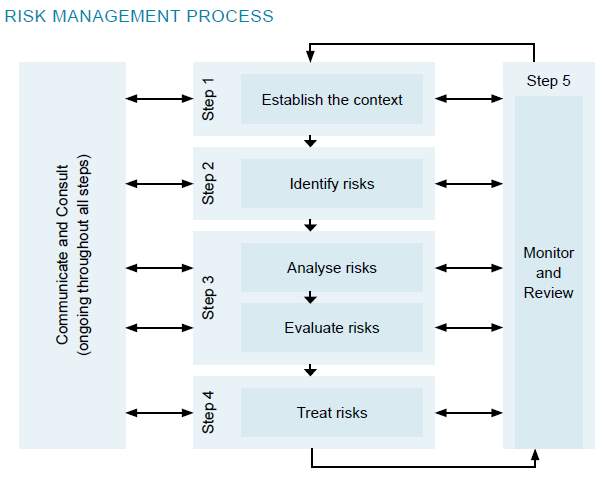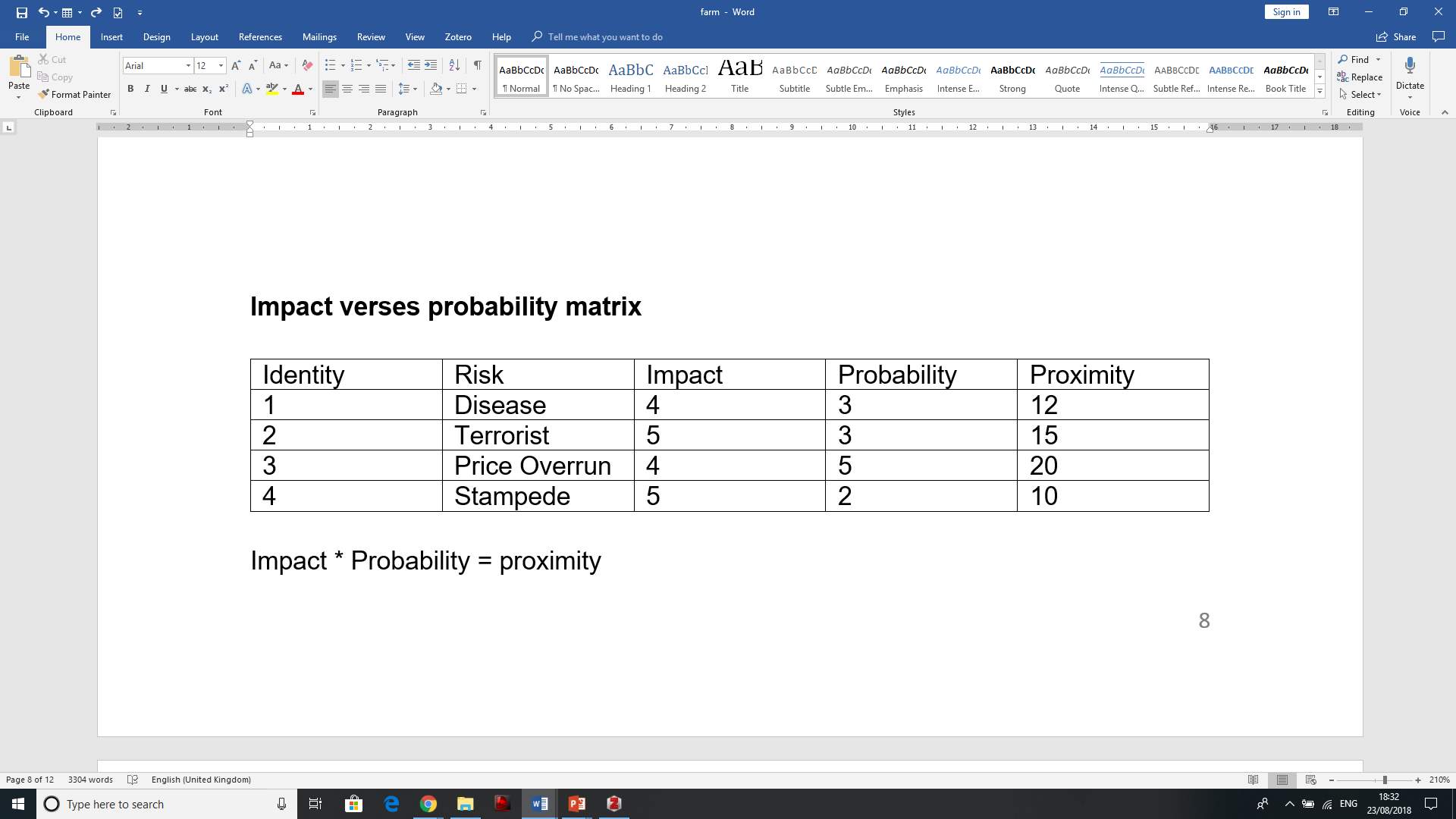Risk Management of an Olympic Games Project
Info: 4726 words (19 pages) Dissertation
Published: 20th Dec 2021
Tagged: Risk Management
Abstract
This report has recognised and discussed three key risk areas involving risk management of an Olympic Games project that has been Informed by risk management concepts and models. It has summarised a multi-stage risk management process that is suitable for an Olympic Games project. It has also Identified four individual risks and discussed their evaluation and suggest potential mitigation strategies.
Financial, political and security were key risk identified by the report and argued for and against in terms of policies applied to find a remedy for the problems. Concept and process identified, and methodologies used to address risk problems are to establish, Identify, analyse, evaluate and treat the risk and monitor for sustenance.
The four individual risk identified in the London 2012 Olympic Games are diseases, terrorist attack, price overruns and stampede. Probability and impact matrix were used to determine the likelihood of an event occurring and the impact it will have on the game. Risk management is an important tool in monitoring projects in project management to avoid unnecessary financial loose.
Introduction
This report will recognise and discuss three key risk areas involving risk management of an Olympic Games project that will be Informed by risk management concepts and models. It will summarise a multi-stage risk management process that is suitable for an Olympic Games project. It will also Identify four individual risks and discuss their evaluation and suggest potential mitigation strategies.
The reason for risk management in an Olympic Games. Risk management is seen as the apex to good management and governance. Its composition is of guidelines and methods as is core, and its application will lead to continual improvement in decision making. Risk management also refers to a sound and methodological way of creating the background, classifying, examining, assessing, treating, observing and communicating risks related with any activity, and procedure by various means to support organisations to decrease losses and capitalize on opportunities.
The report will discuss the area of Financial, Political and Security risk management of the 2012 Olympic Games. It will use risk management process to create the framework, Identify, analyse, evaluate and manage the risk. The report will examine and decide the value of acceptance, avoidance, limitation and risk transfer.
2.0 Risk definition
Project risk is defined by Pinto ( 2016) as uncertainty happening that may have a positive or negative impact on a project goal by way of the scope, schedule, cost and quality. Pinto (2016) also explained risk management as the fishing out, scrutinizing and responding to risk factors during the duration of a project to the benefits of its goals.
2.1 Financial risk
According to Jennings (2008) three uncertainties identified in an Olympic Games project are Financial, Political and Security risk. Per Jennings (2008) accession, Montréal 1976 was a clear example of the financial risk faced as a host nation of the Olympic Games. As it is proved that Montréal progressed to suffer a budget shortfall of additional $1 billion. In an instant of arrogance, Montréal Mayor Jean Drapeau at the time stated that the Olympics is like a man bringing a baby to the world as it is so expensive in its upbringing. Over the past three decades, hosting expenses have varied, shooting past an initial estimation cost. Examples of the total cost out of control of games hosted in Athens 2004 shot up from £3.2bn to £6.3bn, the construction expenses of Vancouver 2010 were equally expensive and over budget. The estimated cost of the London 2012 was 2.4 billion and rose to £9.35 billion, haven a £2.7 billion eventuality money included in its budget.
Since hosting the Olympic games have become a financial risk, recycling hosting venues and facilities may help reduce the financial risk. The international Olympic committee has realised this and have reacted to help reduce the financial risk. According to Butler (2018) over 100 restructurings have been revealed by the International Olympic Committee to help reduce the operative budgets of hosting the Olympic Games. A disclosure by Butler (2018) is that the Olympic Games Delivery Executive Steering Committee chaired by Australia’s John Coates have examined each role of operations, as well as venues, energy, broadcasting, accommodation, transport, technology and the Paralympic Games to implement cost cutting. According to Butler (2018) the IOC has made it a point to work with cities in every positive way to guarantee the affordability of the Olympic Games and making sure it benefits all through sustainability practise.
Long (2016) states that indirectly but very importantly, momentary facilities use will eliminate the expensive cost of occupying urban land for low demand land uses. Cities like Beijing 2008, London 2012, and Rio de Janeiro 2016 have all made use of temporary facilities that have reduced their financial risk. Rio used 35 competition venues, that seven are temporary facilities, and eighteen are existed facilities. The fact that many of the facilities were built for past sporting events such as the Pan-am Games in 2007 and FIFA World Cup in 2014 and can be reused for the Olympic games are a real cost reduction approach.
On the contrary, in this situation of swelling measure, price and complexity, cities still want to host the Olympics Games for a reason. Per Long (2016) accession, some of the reasons from these cities are that ventures in Olympic set-up is frequently regarded as means to control the games for wider economic expansion and urban improvement. The notion behind construction of an Olympic set-up rests in its possibility to improve the city’s brand image, and to arouse new private investment that will lure job creation, produces fresh tax proceeds, and invigorates battered municipal zones. According to Long (2016) the International Olympic Committee has incorporated the idea that host city investments in Olympic infrastructures must be sited as part of a wider municipal program, through extensive pomposity that insist on bidding capitals to generate an Olympic heritage. So far, the potential of the Olympic Games as a reagent for municipal development has regularly not achieved the mission, parting the international Olympic Committee and its organising municipalities difficulties of balancing the costs and reimbursements linked with construction the set-up for the Olympic Games.
2.2 Political risk
According to Nadel (2008) the 2008 Beijing Olympic Games, was an access for the rest of the world to see for themselves an experience of a country that has a poor human right record. To china it was an opportunity to sell themselves out to the rest of the world about their advancement in the world in terms of technology.
Nadel (2008) points out that the world expected China hosting the Olympic Games would have turned the situation around from being a vigilante country to a libertarian one. This was not the case as was reported by the media that hotel rooms were bugged, with invasive security checks on individuals at the airport, and along with restrictive internet access, confirmed what the world has knowledge about which should have been a new day for China.
On the August of the fourth 2008 with barely four days to start the Beijing Olympics a vehicle struck a police station in western China and the perpetrators detonated grenades slaughtering thirty-two police personnel. This was also due to a political rift between Tibet, other regions and China (Nadel, 2008).
On the other hand, it can be argued that China took every measure to avert any political tension between Countries to result into a security risk as it happened in the year 1972, the Munich Olympic Games in a western country city. Munich experienced the west atrocity where eleven Israeli athletes were kidnapped and executed by Palestinians. This was in retaliation of the differences that existed between the two countries. Also, four days to its opening ceremony of the Olympic Games, China encountered a terrorist attack at its western region and lost thirty-two police personnel. This became a food for thought for the international Olympic committee and the host city to prioritise security.
2.3 Security risk
According to Nadel (2008) the incident in Munich during the 1972 Olympics has made security a major concern for public safety. A congregation of thousands of athletes, and other important personnel like the media, dignitaries, and massive spectators in symbolic structures becomes a target for any terrorist organisation to willingly make a statement.
Security at the London 2012 Olympic Games became a matter of worry for the entire United Kingdom. London has had its share of terrorist threats from the Irish Republican Army and the 7th July 2005 train and bus explosion that killed about fifty-six people. Based on this scenarios given it has already invested heavily in over 500,000 surveillance cameras to help monitor security issues (Konstantaki and Wickens, 2010). According to Konstantaki and Wickens (2010) London security issues pertaining to the Olympics 2012 was taken very seriously. An initial cost estimated for security in the year 2005 was 200 million pounds, in 2008 it was estimated to be over 10 billion pounds. In 2009 November the Minister for security Lord West detailed that the British government has revised the potential threat at the 2012 Games from severe to substantial (Konstantaki and Wickens, 2010). Even though the financial impact was high on the tax payers’ pocket, the 2012 Olympics security ensured the safety of all participants, and the country. Due to the previous experience to terrorist attack, the Olympic planning team took nothing for granted but planned to ensure the safety of all by implementing the right measures at a very expensive cost.
3.0 Risk Management process
Risk Management process comprises of five stages:
Stage 1: Establish the context
Stage 2: Identify the risks
Stage 3: Analyse the risks
Stage 4: Evaluate the risks
Stage 5: Treat the risks
Throughout each stage there is discussion and communiqué with team members in the Olympic organisational branches that sums up to make the team. The below diagram by Newman (2016) expresses the various stages in the management process.

3.1 Stage 1: Context establishment
To understand a risk and solve the associated problems it comes with, the relevance of the framework of its existence needs to be understood. The risk boundaries of the Olympics operation must be defined for clarification purposes. This must be followed by the consideration of context establishment:
- The strategic context – the setting within which the Olympic organisation operates
- The organisational context – the objectives, the core activities and operations and objectives of the Olympic organisation.
3.2 Stage 2: Risk identification
The reason for this is to find out what may go wrong, the impact positive or negative and the consequences.
Below are important questions to ask:
- What can occur List risks, and coincidences which can occur by thoroughly skimming through every competition, activity and stage of Olympic games to figure out a probable occurrence at every level.
- Reason for this to happen, enumerate likely the probable reasons and examples of the risk and occurrence.
- Reasons for the likelihood of it occurring.
- What will be the costs if the incident does occur?
3.2.1 Risks types
According to Pinto (2016) the risk types are Physical, Financial, Ethical, Legal, Execution and Commercial.
- Physical risks pertain to individual injuries, environmental, climate situations and the physical possessions of the organisation in terms of properties like buildings, equipment, automobiles, stock and lands.
- Financial risks according to Pinto (2016) are the financial difficulties an organisation bears itself to when creating a development.
- Ethical risks encompass real or possible damage to the status and principles of your organisation.
- legal risks according to Pinto (2016) is mostly familiar with project in which stern terms and settings are tired up in advance.
3.3 Stage 3: Risk analyses and evaluation
This stage encompasses examining the probability and costs of each recognised risk and deciding which risk factors will possibly have the extreme consequence and would, consequently, have precedence with respect to how they will be managed. The level of risk is investigated by merging approximations of possibility as table one illustrates it and its impact as shown by table two and determine the significance stage of the risk as table 3 illustrates it. It is significant to reflect the costs and the possibility of risk in the framework of the activity, the composition of the Olympic games and additional aspects that can change the consequences of possibility of danger.
Risk evaluation includes relating the stage of hazard found during the examination procedure with prior documented risk standards and finding out whether the danger may be known. Low categories of risk may be accepted, and such will have a small additional treatment. Occasionally these dangers should be checked to determine on its acceptability. On the other hand, a risk that fails the acceptability level should be treated with stage four options. Diagrammatic illustration (Darko, 2018).

Table one

Table two

Table three
3.4 Stage 4: Risk treatment
Risk treatment includes finding the variety of choices for solving the danger, assessing those choices, making ready the risk solution plans and applying those methods. It is choosing the best option to solve the problem.
Choices for solving risk issues and the cost involve must be proportionate to a positive outcome. According to Pinto (2016) standard, treatment of choice involves, accepting the risk, avoiding, reducing, transferring, retaining and financing the risk.
Either choice made to solve the risk issue, depends on the ratio of the risk in case it is high consideration of guidelines, methods and strategies to resolve the risk, may involve
- Format for treating the risk
- Responsibility by whom
- Timeframe
- Determinant of the results
3.5 Stage 5: Monitor and review
Monitoring and review are a continuous part of risk management that is essential to each step of the process. Often times this part is neglected and it leads to failures of risk management.
4.0 Four individual Risk
The four individual risk identified in the London 2012 Olympic Games are diseases, terrorist attack, price overruns and stampede. The table below illustrates the risk and the causes.
4.1 Causes and Effect
| Risk | Causes |
| Disease outbreak |
|
| Terrorist attack |
|
| Price overruns |
|
| Stampede |
|
4.2 Impact verses Probability Matrix

4.3 Proximity Table

4.4 Risk impact matrix

4.5 Mitigation strategies
4.5.1 Diseases
According to McCloskey (2013) in identifying diseases as one of the risks that may affect the London 2012 Olympics, the relevant questions to pose were what are the prevailing health risks in London and will the influx of people impact positively or negatively on the current situation? The measures in place monitors every public health situation and immediately remedy a solution for any issue that may arise. Denholm and Thevarajan (2016) states that where complete risk is refereed to be satisfactorily high, pre-travel testing for LTBI may be indicated. Pre-travel testing is specified mainly to ascertain the starting point TB infection status of travellers, permitting for acknowledgement of travel linked to exposure through change from negative to positive, and enabling involvements to decrease development to active illness. By McCloskey and Endericks (2013) assertion, detection mechanisms for any health risk in place will deepen strongly the public health surveillance system implemented during the games. Making a success out of the management of the public health issues that people might be exposed to during the games depends on detailed structure meant to capture any eventuality before and after the games.
4.5.2 Terrorist
The Home Office (2011) documentation revealed that through July and August 2010, the Government led an evaluation and review of the London 2012 Games, its Safety and Security led by the Minister of State for Security and Counter-Terrorism. The assessment and review instituted that the principles of this multiagency that is the Olympic and Paralympic Safety and Security Strategy were comprehensive and that strategies should continue to be based on it (Home office, 2011). Since the intentions of a terrorist cannot be stopped but can be prevented, mechanisms by the security agencies implemented to monitor and police the games have been well dealt by all the government agencies. According to the Home Office (2011) the pledges from the Prime Minister, the Home Secretary and the Chancellor of the Exchequer are all assurances made for the public to feel safe through moneys and personnel made available during the 2012 Olympic Games.
4.5.3 Price overruns
Flyvbjerg and Stewart (2012) assert that the London 2012 Games, is noticed to exceed the record held for sports-related actual costs presently valued at USD14.8 billion, London is on the pathway of becoming the costliest Olympics ever. Flyvbjerg and Stewart (2012) noticed an expected cost overrun of hundred and one percent in actual terms, an overrun for London is below the past regular cost for the Games, but then again not suggestively so. Compared to the London price overrun is, but, suggestively higher than overruns for recent Games starting from the year 1999. London consequently is moving back from a positive inclination of dropping cost overruns for the Game.
On the contrary the kidnapping and execution of eleven Israeli athletes in 1972 in Munich has been an eye opener for security measures to be top notch to help prevent and safe lives through monitoring. Also, was the 7th July 2005 London tube and bus bombing killing fifty-six people. All these new technologies are so expensive and adding it to an initial estimated cost will always increase the cost of hosting the Olympic games.
4.5.4 Stampede
According to Academy (2010) Britain exhibits comparable sport safety and security matters to the United States such as terrorism (Steinbach, 2006) and crowd management issues (Pearson, 2006). A scrutiny of the English football security arrangement highpoints plans, legislation, and risk management practices efficiently used to control unlawful conduct at events.
Academy (2010) stated that sports program facing unlawful fan behaviour and crowd control problems may consider utilizing fan seating arrangement and ticketing policies to divide opposing supporters. Sport event managers could also apply ticket taking and screening plans by separating fans into assemblies before they enter the stadium by establishing two entry lines, group one made up of supporters with tickets only, and group two made up of supporters with bags and personal items that may be examined based on the facility’s forbidden items procedure. According to Academy (2010) management of the Olympic Games can likewise contemplate adopting the football association program, by way that the sport leagues service staff associates to make their presence visible not only at the perimeter of the stadium, but also at any train, tube stations, and swift transport stations, where fans congregate to attend the
games. The management of alcohol is also important. Alcohol drinking should be controlled to check public disorder. Academy (2010) indicates further that, the sport group could wish to ban any individual who is detained or expelled from the stadium and any person in receipt of a prohibition order could be disallowed from attending games for a period of up to five years to serve as a deterrent for bad behaviour.
5.0 Conclusion
This report has recognised and discussed three key risk areas involving risk management of an Olympic Games project that has been Informed by risk management concepts and models. It has summarised a multi-stage risk management process that is suitable for an Olympic Games project. It has also Identified four individual risks and discussed their evaluation and suggest potential mitigation strategies.
Financial, political and security were key risk identified by the report and argued for and against in terms of policies applied to find a remedy for the problems. Concept and process identified, and methodologies used to address risk problems are to establish, Identify, analyse, evaluate and treat the risk and monitor for sustenance.
The four individual risk identified in the London 2012 Olympic Games are diseases, terrorist attack, price overruns and stampede. Probability and impact matrix were used to determine the likelihood of an event occurring and the impact it will have on the game. Risk management is an important tool in monitoring projects in project management to avoid unnecessary financial loose.
6.0 Referencing List
Academy, U. S. S. (2010) ‘An Examination of British Sport Security Strategies, Legislation, and Risk Management Practices’, The Sport Journal, 9 April. Available at: http://thesportjournal.org/article/an-examination-of-british-sport-security-strategies-legislation-and-risk-management-practices/ (Accessed: 22 August 2018).
Butler, N. (2018) IOC launch reforms they claim could save cities hosting the Olympics $1 billion. Available at: http://www.insidethegames.biz/articles/1061122/ioc-launch-reforms-they-claim-could-save-cities-hosting-the-olympics-1-billion (Accessed: 17 August 2018).
Denholm, J. T. and Thevarajan, I. (2016) ‘Tuberculosis and the traveller: evaluating and reducing risk through travel consultation’, Journal of Travel Medicine. doi: 10.1093/jtm/taw008.
Flyvbjerg, B. and Stewart, A. (2012) ‘Olympic Proportions: Cost and Cost Overrun at the Olympics 1960-2012’, SSRN Electronic Journal. doi: 10.2139/ssrn.2238053.
Home Office (2011) ‘Olympic and Paralympic Safety and Security Strategy’, p. 23.
Jennings, W. (2008) ‘London 2012: Olympic Risk, Risk Management and Olymponomics’, Olymponomics, 29 September. Available at: https://olymponomics.wordpress.com/2008/09/29/london-2012-olympic-risk-risk-management-and-olymponomics/ (Accessed: 17 August 2018).
Konstantaki, M. and Wickens, E. (2010) ‘Residents’ Perceptions of Environmental and Security Issues at the 2012 London Olympic Games’, Journal of Sport & Tourism, 15(4), pp. 337–357.
Long, J. G. (2016) ‘Media Objects Articles Rethinking Olympic Infrastructure En Gb’. Available at: https://lsecities.net/media/objects/articles/rethinking-olympic-infrastructure/en-gb (Accessed: 17 August 2018).
McCloskey, B. and Endericks, T. (2013) ‘Learning from London 2012: A practical guide to public health and mass gatherings’, p. 132.
Nadel, B. A. (2008) Olympic Games Security: Conventional Wisdom on Safety at Public Venues. Available at: https://www.buildings.com/article-details/articleid/6370/title/olympic-games-security-conventional-wisdom-on-safety-at-public-venues/viewall/true (Accessed: 20 August 2018).
Pinto, J. K. (2016) Read: Project management. Available at: http://reader.vlebooks.com/reader/open?accId=10402&cite=1&isbn=9781292122717&maxCopy=56&maxPrint=56&mmLimit=0¬es=1&pageLimit=0&shareLink=%2F%2FWWW.VLEBOOKS.COM%2FVLEWEB%2FPRODUCT%2FINDEX%2F697426&startPage=0×tamp=2018-08-17T10%3A41%3A05&userId=1071860&watermark=++++++++++++++++++++++++++++++BEDSUNI%2FSFBQTNZPAKX3EFE1BWL2VVVNNUNTDWXDAMD3PQ++++++++++++++++++++++++++++++&token=sSppj6HrQSBxL592C%2bXdHy5znzo%3d (Accessed: 17 August 2018).
Cite This Work
To export a reference to this article please select a referencing stye below:
Related Services
View allRelated Content
All TagsContent relating to: "Risk Management"
Risk Management is a process for identifying, understanding and mitigating any risks that are associated with a particular task or event. Individuals and organisations implement Risk Management to provide a layer of protection, allowing them to minimise risk in their operations.
Related Articles
DMCA / Removal Request
If you are the original writer of this dissertation and no longer wish to have your work published on the UKDiss.com website then please:




